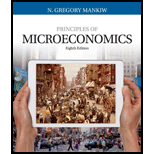
Principles of Microeconomics (MindTap Course List)
8th Edition
ISBN: 9781305971493
Author: N. Gregory Mankiw
Publisher: Cengage Learning
expand_more
expand_more
format_list_bulleted
Question
Chapter 18, Problem 3PA
Subpart (a):
To determine
Calculate marginal product of labor.
Subpart (b):
To determine
Calculate value of marginal product of labor.
Subpart (c):
To determine
Demand and equilibrium price of an apple.
Subpart (d):
To determine
Demand and equilibrium price of an apple.
Subpart (e):
To determine
Demand and equilibrium price of an apple.
Expert Solution & Answer
Trending nowThis is a popular solution!

Students have asked these similar questions
epidemology/economics
Don't use ai to answer I will report you answer
Which of the following is true about the concept of concentration?
Group of answer choices
The lower the degree of rivalry amongst the firms, the higher the concentration.
The lower the number of firms in a market, the lower the concentration.
All of the answers are correct.
The higher the degree of rivalry amongst the firms, the lower the concentration
Chapter 18 Solutions
Principles of Microeconomics (MindTap Course List)
Knowledge Booster
Similar questions
- ↑ Quiz x Chat × | Use ☑ Micr ☑ Price × b Ans × b Suco × b Anst ✓ Pow × 1.6: ✓ ECO ☑ #26 ☑ #27 ✓ #28 ✓ -0 -0 setonhall.instructure.com/courses/30968/quizzes/52774/take/questions/1035198 Question 15 2 pts Use the information contained in the graph below describing a firm operating in a competitive environment to answer the following question. If the graph described a firm that decides to produce, what would be the value of its profit, its deficit, or would it break even? $7 385 $8 $4 4 120 150 30 50 50 None of the answers are correct. #29 × N. price × | + ☆ ☑ B Relaunch to update :arrow_forward↑ Quiz: F X . ChatG × G Use th × b Answe × b Answe ☑ Micros ☑ Power × 1.6: A ☑ ECON ✓ #26 - X #27 - X #28 - X #29 - × G is mr c ×+ -o -0 setonhall.instructure.com/courses/30968/quizzes/52774/take/questions/1035213 Q ☆ B Relaunch to update : Question 9 2 pts Use the information contained in the three graphs below to answer the following question. Which of the three curves represent the MR? (A) (B) $800 $800 $800 $700 $700 $700 $600 $600 $600 $500 $500 $500 67 S S $400 $400 $400 $300 $300 $300 $200 $200 $200 $100 $100 $100 50 50 30 01 01 2 34 01 A None of the curves could be the answer. C B (C)arrow_forwardProfits will be_________? Group of answer choices High, regardless of the degree of rivalry between competitors. Low, when the degree of rivalry between competitors is low. High, when the degree of rivalry between competitors is high. Low, when the degree of rivalry between competitors is high.arrow_forward
- Not use ai pleasearrow_forwardQuestion 8 Which of the following is true about the concept of concentration? O All of the answers are correct. O O The lower the number of firms in a market, the lower the concentration. The higher the degree of rivalry amongst the firms, the lower the concentration. The lower the degree of rivalry amongst the firms, the higher the concentration. Previous 2 pts Next ->arrow_forwardQuestion 15 Price discrimination is usually defined as selling a product to different customers at The same price as costs of service are the same. Different prices even though costs of service are the same. The same price even though costs of service are different. Different prices as costs of service are different. ? 2 pts ◄ Previous Next -arrow_forward
- Question 22 2 pts Use the information contained in the three graphs below to answer the following question. Which of the three curves could display an efficiency scale? (A) 5800 $700 5600 $500 (B) $800 $700 (C) ccc $400 $300 $200 $300 $200 $100 $100 $400 $300 $300 $100 1 $800 $700 S $600 A None of the curves could be the answer. B C ◄ Previous Next ->arrow_forwardUse the information contained in the graph below to answer the following question. Which of the curves could represent marginal costs? O A C B O None of the curves could be the answer. B ◄ Previous Next ▸arrow_forwardNot use ai pleasearrow_forward
arrow_back_ios
SEE MORE QUESTIONS
arrow_forward_ios
Recommended textbooks for you



 Principles of Microeconomics (MindTap Course List)EconomicsISBN:9781305971493Author:N. Gregory MankiwPublisher:Cengage Learning
Principles of Microeconomics (MindTap Course List)EconomicsISBN:9781305971493Author:N. Gregory MankiwPublisher:Cengage Learning





Principles of Microeconomics (MindTap Course List)
Economics
ISBN:9781305971493
Author:N. Gregory Mankiw
Publisher:Cengage Learning
